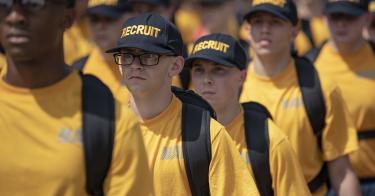Every employer—public or private—recruits workers. What sets military recruiting apart is the nature and the stakes involved in the work to be done: The job is defending the nation, and the penalties for failure are death and defeat.
With stakes this high, recruiting standards should be high as well. They are vital to both the nation’s defense and the recruit’s survival.
That’s why the Navy’s announcement that it is lowering minimum scores on the Armed Forces Qualification Test and lifting its recruiting age limit from 35 years old to 41 is worrisome. If not accompanied by added safeguards, these changes signal bad faith toward the nation and the recruit.
It’s no secret why the Navy is lowering standards: Its recruitment program is in heavy seas. The service failed to meet its 2020 recruiting goals. As a result, it has fewer people in training to serve in the fleet—and that fleet has a key role to play if the U.S. is stay ahead of the fast-rising China threat.
>>> The U.S. Navy Must Grow To Confront China (but We Must Study Past Sins)
The Navy is a service steeped in technology and engineering. It is essential to survival in modern naval combat. Any softening of technical aptitude standards necessarily entails higher risk.
Accepting less technically apt recruits means more training will be needed before they arrive at their first ship. If the added training is not provided, these recruits will be at a technical disadvantage, with lower prospects for promotion. And, as fatal collisions in 2017 demonstrated, it also raises the risk of suffering serious shipboard accidents.
Failing to make allowances for less technically apt recruits breeds resentments that can and have boiled over in the past. The October 1972 riots on the aircraft carrier Kitty Hawk, while conducting strike missions on North Vietnam, is an example of this.
Tensions on board that ship had simmered for months over the perception that the worst jobs were assigned to Black sailors. The Navy then was not an all-volunteer force, and sailors drafted into service often had disadvantaged educational backgrounds. No surprise, then, that dirty and uncomfortable jobs were often filled by those with the lowest scores on the Armed Forces Qualification Test.
This unbalanced starting point contributed to resentments and incidents that led to riots on two other ships: the Constellation and the Hassayampa. As the Navy permits less technically apt volunteers to enlist, it must ensure fairness of opportunity in the assignment of occupational fields if it is to avoid a resurgence of such disciplinary problems.
To meet its recruiting needs, the Navy must visibly engage in more high schools and communities—including those not known for delivering volunteers for military service. This can introduce more people to the merits of naval service. Studies indicate that this approach would improve recruiting.
>>> China’s Growing Naval, Air Operations in East Asia Represent Dangerous “New Normal”
A better long-term solution would be for high schools to produce more technically apt graduates—and the Junior Reserve Officer Training Corps (JROTC) has proved that it can help do that. Given this track record, some disadvantaged school districts have turned to JROTC—a move that has improved attendance, reduced disciplinary problems and delivered higher graduation rates.
We are in the midst of a dangerous decade. War rages in Europe, and China is increasingly confident it can win a major conflict with the U.S. over Taiwan.
In times like these, the Navy needs every citizen willing to enlist to be ready for an environment where life and death at sea are heavily based in technical competence.
Failing to prepare recruits with less technical aptitude for a life at sea is hiring in bad faith. And unless the Navy acts to prepare, it will come at personal expense to the recruit, undue loss of taxpayer resources from higher accident rates, and potentially a loss in war.
This piece originally appeared in The Washington Times




